

Thickening agent. "Thickener" redirects here.
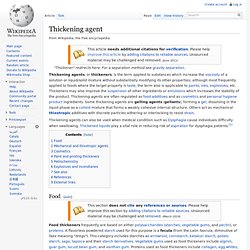
For a separation method see gravity separation. Thickening agents can also be used when medical condition such as Dysphagia cause individuals difficulty when swallowing. Thickened liquids play a vital role in reducing risk of aspiration for dysphagia patients.[1] Food[edit] Food thickeners frequently are based on either polysaccharides (starches, vegetable gums, and pectin), or proteins.
Cassava starch. The development of both the food and non food uses of cassava starch has made much progress and continues to have a bright future.
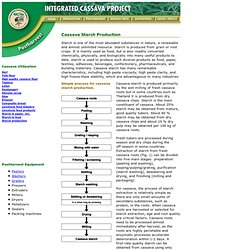
Both old and important new products, such as modified starches, starch sugars, starch-based plastics and fuel alcohol, are reviewed briefly. Native starches Starch can be classified into two types: native and modified. Native starches are produced through the separation of naturally occurring starch from either grain or root crops, such as cassava, maize, and sweetpotato, and can be used directly in producing certain foods, such as noodles. The raw starches produced still retain the original structure and characteristics and are called “native starches”. Native starches have limited usage, mainly in the food industry, because they lack certain desired functional properties. Modified Starches. CASSAVA STARCH PRODUCTION IN NIGERIA, THE FEASIBILITY REPORT. Report Description: Cassava (Manihort Esculentus (Euphorbiacea)) is grown in all the states of the Federation with the current production level being about 45 million metric tones per annum; a figure expected to double by 2020.
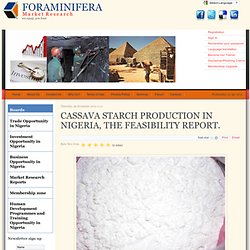
Nigeria is the leading cassava producer in the world, producing a third more than Brazil and almost double the production capacity of Thailand and Indonesia. Industrial cassava starch production. Traditionally, wet cassava starch is produced by cassava processors either as a direct product or as a by-product resulting from cassava processing into other products such as Gari, Fufu, etc.
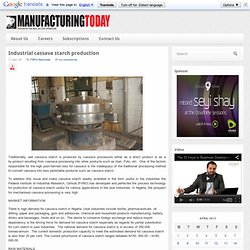
One of the factors responsible for the high post-harvest loss for cassava is the inadequacy of the traditional processing method to convert cassava into less perishable products such as cassava starch. To address this issue and make cassava starch readily available in the form useful in the industries the Federal Institute of Industrial Research, Oshodi (FIIRO) has developed and perfected the process technology for production of cassava starch useful for various applications in the user industries. In Nigeria, the prospect for mechanised cassava processing is very high. Starch. Starch or amylum is a carbohydrate consisting of a large number of glucose units joined by glycosidic bonds.

This polysaccharide is produced by most green plants as an energy store. It is the most common carbohydrate in human diets and is contained in large amounts in such staple foods as potatoes, wheat, maize (corn), rice, and cassava. Pure starch is a white, tasteless and odorless powder that is insoluble in cold water or alcohol. It consists of two types of molecules: the linear and helical amylose and the branched amylopectin. Depending on the plant, starch generally contains 20 to 25% amylose and 75 to 80% amylopectin by weight.[1] Glycogen, the glucose store of animals, is a more branched version of amylopectin. Rheology. Newtonian fluids can be characterized by a single coefficient of viscosity for a specific temperature.

Although this viscosity will change with temperature, it does not change with the strain rate. Only a small group of fluids exhibit such constant viscosity, and they are known as Newtonian fluids. But for a large class of fluids, the viscosity changes with the strain rate (or relative velocity of flow) are called non-Newtonian fluids. Rheology generally accounts for the behaviour of non-Newtonian fluids, by characterizing the minimum number of functions that are needed to relate stresses with rate of change of strains or strain rates. For example, ketchup can have its viscosity reduced by shaking (or other forms of mechanical agitation, where the relative movement of different layers in the material actually causes the reduction in viscosity) but water cannot. The term rheology was coined by Eugene C. Scope[edit] Effect of glycerol concentration and temperature on the rheological properties of cassava starch solutions : Journal of Polymer Engineering.
Rheological properties of dilute aqueous solutions of cassava starch. International Starch: Tapioca starch applications; International Starch TradingScience Park Aarhus, Denmark Tapioca Starch Applications | Functionality | ERH | E-Numbers | ApplicationTable | Recipes | FructoseSyrup | GlucoseSyrup | ApplicationIndex | Applications by Industry Textiles (Sizing and Dyeing) Food Industries and Sweets Manufacturers Pet Food industry Fish Feed industry (The industry is growing 40% per annum) Paper and Paper Cone industries Ice Cream and Ice Cream Cone Manufacturers.

International Starch: Tapioca Food Starch; International Starch TradingScience Park Aarhus, Denmark Tapioca Food Starch | Functionality | ERH | E-Numbers | ApplicationTable | Recipes | FructoseSyrup | GlucoseSyrup | ApplicationIndex |
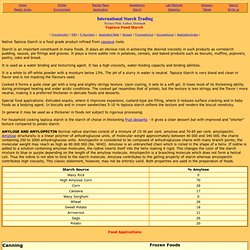
Cassava starch. STARCH TECHNOLOGY - Starch in the food industry. China Afghanistan. 22. Five Tips to Becoming a Killer Scientist Who Changes the World. I've been thinking a great deal about how researchers can become better at their craft.

Part of their job is to uncover mysteries about the universe. Part of their job is to communicate these ideas to the world. Ignore the latter and your chances of improving the world in some small way becomes miniscule. If you are a scientist, want to become one, live with one, fail to understand them, or are trying to avoid them, this blog post is for you. Why Nikola Tesla was the greatest geek who ever lived. Additional notes from the author: If you want to learn more about Tesla, I highly recommend reading Tesla: Man Out of Time Also, this Badass of the week by Ben Thompson is what originally inspired me to write a comic about Tesla.
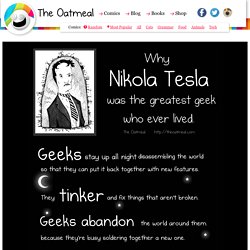
Ben's also got a book out which is packed full of awesome. There's an old movie from the 80s on Netflix Instant Queue right now about Tesla: The Secret of Nikola Tesla. It's corny and full of bad acting, but it paints a fairly accurate depiction of his life. The drunk history of Tesla is quite awesome, too. Bio products from bio refineries - trends, challenges and opportunities. Bhima Vijayendran A recent study estimates that, by 2025, over 15% of the three trillion dollar global chemical sales will be derived from bio-derived sources.
Many of these bioproducts would be manufactured in bio-refineries by the deployment of rapidly emerging industrial biotechnology. It is expected that bioderived chemicals will come from three sources: direct production using conventional thermochemical and catalytic process, biorefining, and expression in plants. Direct production is already a reality, as evidenced by the production of propane diol and polylactic acid from corn-derived glucose and others. Nuclear Fusion Reactor - Overview. Cross Fire Fusion Reactor Author: Moacir L. How I built an electricity producing wind turbine. Several years ago I bought some remote property in Arizona. I am an astronomer and wanted a place to practice my hobby far away from the sky-wrecking light pollution found near cities of any real size. I found a great piece of property. The problem is, it's so remote that there is no electric service available. That's not really a problem.
No electricity equals no light pollution. Beta particle. Alpha radiation consists of helium nuclei and is readily stopped by a sheet of paper. Beta radiation, consisting of electrons or positrons, is halted by an aluminum plate. Gamma radiation is dampened by lead. Alpha particle. Alpha particles consist of two protons and two neutrons bound together into a particle identical to a helium nucleus. They are generally produced in the process of alpha decay, but may also be produced in other ways. Alpha particles are named after the first letter in the Greek alphabet, α.
The symbol for the alpha particle is α or α2+. Because they are identical to helium nuclei, they are also sometimes written as He2+ or 4 2He2+ indicating a Helium ion with a +2 charge (missing its two electrons). If the ion gains electrons from its environment, the alpha particle can be written as a normal (electrically neutral) Helium atom 4 2He. Reactor. Thorium reactors would be cheap. The primary cost in nuclear reactors traditionally is the huge safety requirements.
Regarding meltdown in a thorium reactor, Rubbia writes, “Both the EA and MF can be effectively protected against military diversions and exhibit an extreme robustness against any conceivable accident, always with benign consequences. Nuclear, Oil, Gas, Renewables - All on Table. Ever have one of those moments when you turn on the car and the radio is playing your favorite song?
I had one the other day, only it wasn't a song that was playing. It was noontime talk radio, and an energy investment expert was being interviewed and taking listener questions. This guy's view of the energy industry was nearly identical to mine. Could the "Great Gas Out" actually work? Maybe, but only in the short term. Since about 1997, a meme has been travelling through the Internet that by somehow not buying gas on a certain day, the oil companies will somehow lower the prices. China Takes Lead in Race for Clean Nuclear Power. China has officially announced it will launch a program to develop a thorium-fueled molten-salt nuclear reactor, taking a crucial step towards shifting to nuclear power as a primary energy source. The project was unveiled at the annual Chinese Academy of Sciences conference in Shanghai last week, and reported in the Wen Hui Bao newspaper (Google English translation here). If the reactor works as planned, China may fulfill a long-delayed dream of clean nuclear energy.
Meet the scientific accident that could change the world. Well, going by the video it appears to be have comparable energy density to similarly sized but expensive rechargeable watch batteries. The key breakthroughs are, I think: Meet the scientific accident that could change the world. MIT creates glucose fuel cell to power implanted brain-computer interfaces. Neuroengineers at MIT have created a implantable fuel cell that generates electricity from the glucose present in the cerebrospinal fluid that flows around your brain and spinal cord.
In theory, this fuel cell could eventually drive low-power sensors and computers that decode your brain activity to interface with prosthetic limbs. The glucose-powered fuel cell is crafted out of silicon and platinum, using standard semiconductor fabrication processes. Solar panel made with ion cannon is cheap enough to challenge fossil fuels. Twin Creeks, a solar power startup that emerged from hiding today, has developed a way of creating photovoltaic cells that are half the price of today’s cheapest cells, and thus within reach of challenging the fossil fuel hegemony. The best bit: Twin Creeks’ photovoltaic cells are created using a hydrogen ion particle accelerator. Super-efficient solar-energy technology: ‘Solar steam’ so effective it can make steam from icy cold water. Rice University scientists have unveiled a revolutionary new technology that uses nanoparticles to convert solar energy directly into steam.
In Search of Energy Miracles. How Cold Fusion Works. ISIS Report 23/10/07. Freak discovery could lead to new biofuel. Asphaltene. Possible asphaltene molecule Asphaltenes are molecular substances that are found in crude oil, along with resins, aromatic hydrocarbons, and saturates (i.e. saturated hydrocarbons such as alkanes).[1][2] The word "asphaltene" was coined by Boussingault in 1837 when he noticed that the distillation residue of some bitumens had asphalt-like properties.
Asphaltenes in the form of asphalt or bitumen products from oil refineries are used as paving materials on roads, shingles for roofs, and waterproof coatings on building foundations. Composition[edit] Drilling. Synthesis and application of polyaminoamide as new paraffin inhibitor from vegetable oil. Process design. Chemical process modeling. Guide for Writing Project Proposals. Sample-Project-Porposal. International Starch: ISI 19 Determination of Viscosity of Starch by Brabender - Comments.